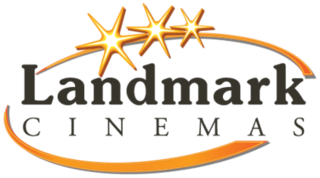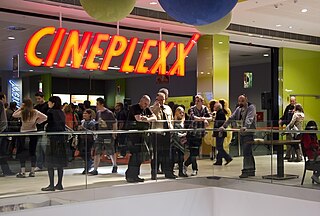
Digital cinema refers to the adoption of digital technology within the film industry to distribute or project motion pictures as opposed to the historical use of reels of motion picture film, such as 35 mm film. Whereas film reels have to be shipped to movie theaters, a digital movie can be distributed to cinemas in a number of ways: over the Internet or dedicated satellite links, or by sending hard drives or optical discs such as Blu-ray discs.

THX is a suite of high fidelity audiovisual reproduction standards for movie theaters, screening rooms, home theaters, computer speakers, video game consoles, car audio systems, and video games. The THX trailer that precedes movies is based on the Deep Note, with a distinctive glissando up from a rumbling low pitch.

IMAX is a proprietary system of high-resolution cameras, film formats, film projectors, and theaters known for having very large screens with a tall aspect ratio and steep stadium seating, with the 1.43:1 ratio format being available only in few selected locations.

Home cinema, also called home theaters or theater rooms, are home entertainment audio-visual systems that seek to reproduce a movie theater experience and mood using consumer electronics-grade video and audio equipment that is set up in a room or backyard of a private home. Some studies show that films are rated better and generate more intense emotions when watched in a movie theater, but convenience is a major appeal for home cinemas. In the 1980s, home cinemas typically consisted of a movie pre-recorded on a LaserDisc or VHS tape; a LaserDisc Player or VCR; and a heavy, bulky large-screen cathode ray tube TV set, although sometimes CRT projectors were used instead. In the 2000s, technological innovations in sound systems, video player equipment and TV screens and video projectors have changed the equipment used in home cinema set-ups and enabled home users to experience a higher-resolution screen image, improved sound quality and components that offer users more options. The development of Internet-based subscription services means that 2020s-era home theatre users do not have to commute to a video rental store as was common in the 1980s and 1990s.

Surround sound is a technique for enriching the fidelity and depth of sound reproduction by using multiple audio channels from speakers that surround the listener. Its first application was in movie theaters. Prior to surround sound, theater sound systems commonly had three screen channels of sound that played from three loudspeakers located in front of the audience. Surround sound adds one or more channels from loudspeakers to the side or behind the listener that are able to create the sensation of sound coming from any horizontal direction around the listener.

Dolby Laboratories, Inc. is a British-American technology corporation specializing in audio noise reduction, audio encoding/compression, spatial audio, and HDR imaging. Dolby licenses its technologies to consumer electronics manufacturers.

The Empire, Leicester Square is a cinema currently operated by Cineworld on the north side of Leicester Square, London, United Kingdom.

The Odeon Luxe Leicester Square is a prominent cinema building in the West End of London. Built in the Art Deco style and completed in 1937, the building has been continually altered in response to developments in cinema technology, and was the first Dolby Cinema in the United Kingdom.
The Deep Note is the sound trademark of THX Ltd., being a distinctive synthesized crescendo that glissandos from a relatively narrow frequency spread to a broader frequency spread. It was created by James A. Moorer, a former employee of Lucasfilm's Computer Division in late 1982. The sound is used on trailers for THX-certified movie theaters, home video releases, video games, and in-car entertainment systems.
Goodrich Theater NewCo, LLC. is a chain of 22 movie theaters, headquartered in Grand Rapids, MI, representing a total of 174 screens in the United States. The majority of GQT Movies' locations are in Michigan, but other locations could be found in Illinois, Indiana, Missouri, Alabama, and Pennsylvania. The company filed for Chapter 11 Bankruptcy protection in February 2020. All employees were terminated March 19, 2020 without notice largely due to the COVID-19 pandemic, as many movie theaters were closed by government order in many states. In last July 2020, the company began reopening some of their locations. By the end of the year it had reopened its 22 locations.

Cinema City is a brand of multiplex cinemas in eastern and central Europe, run by the Israeli company Cinema City International (CCI). In Europe it has cinemas in Romania, Bulgaria, Hungary, Poland, Czech Republic and Slovakia. In Poland, Cinema City has almost 40% of the multiplex market, with Multikino its major competitor. CCI also runs a chain of Israeli multiplexes under the name of Rav-Hen.

Landmark Cinema of Canada Inc. is a Canadian cinema chain. Based in Calgary, Alberta, Landmark operates 39 theatres with 317 screens, primarily in Ontario and western Canada. Its holdings include much of the former Empire Theatres chain which it acquired in late 2013, and some Famous Players locations divested as part of that chain's purchase by Cineplex Entertainment. Landmark is the second-largest cinema chain in Canada after Cineplex. It was acquired by Belgium company Kinepolis in 2017 for $123 million.
Megabox Joongang is a multiplex cinema chain in South Korea, and the third largest multiplex theater company in the country, after CJ CGV and Lotte Cinema. It is headquartered in Cheongdam-dong, Gangnam-gu, Seoul. It was established in 2000 as a joint venture between Orion Confectionery and Loews Cineplex Entertainment, owned jointly by Sony Pictures and Universal Studios. It later merged with Cinus, owned by JoongAng Group's Media Network, in 2010. Currently, it operates 722 screens at 105 locations nationwide.
Qube Cinema Technologies is an Indian company operating in film and television technology. It provided digital non-linear editing and digital cinema sound to the Indian market in the 1990s. The company then began work in digital cinema products and deployment during the early years of the century.

Cineplexx is a cinema company based in Vienna, Austria, owned by Constantin Film-Foundation. The company was founded in 1993, and operates mainly in Austria where it is the largest cinema chain with 28 locations, mostly multiplex cinemas under the Cineplexx brand. The company started international expansion in 2009 and operates 61 multiplexes in 12 countries as of 2021.
Dolby Atmos is a surround sound technology developed by Dolby Laboratories. It expands on existing surround sound systems by adding height channels, allowing sounds to be interpreted as three-dimensional objects with neither horizontal nor vertical limitations. Following the release of Atmos for the cinema market, a variety of consumer technologies have been released under the Atmos brand, using in-ceiling and up-firing speakers.

Auro 11.1 is one of the cinematic speaker layouts of the Auro-3D format, invented in 2005 by Wilfried Van Baelen. The Auro 11.1 cinema audio format is supported by Barco, a global visualization technology and digital cinema projection company.
Auro-3D is an immersive 3D audio format developed by the Belgium-based company Auro Technologies.

Vue West End is a nine-screen cinema complex in Leicester Square, London, operated by Vue Cinemas. The multiplex was constructed in 1993 on the site of what was previously the Warner West End cinema.

Dolby Cinema is a premium cinema created by Dolby Laboratories that combines Dolby proprietary technologies such as Dolby Vision and Dolby Atmos, as well as other signature entrance and intrinsic design features. The technology competes with IMAX and other premium large formats such as Cinemark XD and Regal's RPX.















